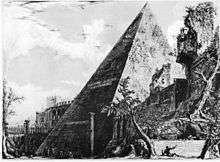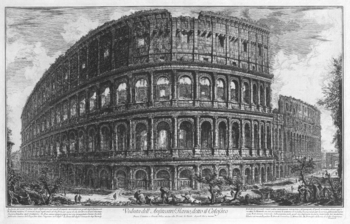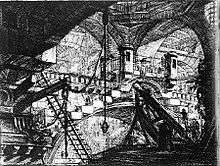Giovanni Battista Piranesi
| Piranesi | |
|---|---|
 Self-portrait of Piranesi. | |
| Born |
4 October 1720 Mogliano Veneto |
| Died |
9 November 1778 (aged 58) Rome |
| Nationality | Italian |
| Education | Matteo Lucchesi |
| Known for | Etching |
| Notable work | Le Carceri d'Invenzione and etchings of Rome |
| Movement | Neoclassicism |
Giovanni Battista (also Giambattista) Piranesi (Italian pronunciation: [dʒoˈvanni batˈtista piraˈneːzi]; 4 October 1720 – 9 November 1778) was an Italian artist famous for his etchings of Rome and of fictitious and atmospheric "prisons" (Le Carceri d'Invenzione).
Biography
Piranesi was born in Mogliano Veneto, near Treviso, then part of the Republic of Venice. His brother Andrea introduced him to Latin and the ancient civilization, and later he studied as an architect under his uncle, Matteo Lucchesi, who was Magistrato delle Acque, a Venetian engineer who specialized in excavation.
From 1740 he was in Rome with Marco Foscarini, the Venetian envoy to the Vatican. He resided in the Palazzo Venezia and studied under Giuseppe Vasi, who introduced him to the art of etching and engraving. After his studies with Vasi, he collaborated with pupils of the French Academy in Rome to produce a series of vedute (views) of the city; his first work was Prima parte di Architettura e Prospettive (1743), followed in 1745 by Varie Vedute di Roma Antica e Moderna.

From 1743 to 1747 he sojourned mainly in Venice where, according to some sources, he often visited Giovanni Battista Tiepolo. He then returned to Rome, where he opened a workshop in Via del Corso. In 1748–1774 he created a long series of vedute of the city which established his fame. In the meantime Piranesi devoted himself to the measurement of many of the ancient edifices: this led to the publication of Le Antichità Romane de' tempo della prima Repubblica e dei primi imperatori ("Roman Antiquities of the Time of the First Republic and the First Emperors"). In 1761 he became a member of the Accademia di San Luca and opened a printing facility of his own. In 1762 the Campo Marzio dell'antica Roma collection of engravings was printed.
The following year he was commissioned by Pope Clement XIII to restore the choir of San Giovanni in Laterano, but the work did not materialize. In 1764 Piranesi started his sole architectural works of importance, the restoration of the church of Santa Maria del Priorato in the Villa of the Knights of Malta in Rome, where he was buried in a tomb designed by Giuseppi Angelini.
In 1767 he was created a knight of the Golden Spur, which enabled him henceforth to sign himself "Cav[aliere] Piranesi". In 1769 his publication of a series of ingenious and sometimes bizarre designs for chimneypieces, as well as an original range of furniture pieces, established his place as a versatile and resourceful designer.[1] In 1776 he created his famous Piranesi Vase, his best known work as a 'restorer' of ancient sculpture. In 1777–78 Piranesi published Avanzi degli Edifici di Pesto, (Remains of the Edifices of Paestum) a collection of views of Paestum.
He died in Rome in 1778 after a long illness and was buried in the Church of Santa Maria del Priorato, on the Aventine hill in Rome.

The Views (Vedute)

The remains of Rome kindled Piranesi's enthusiasm. He was able to faithfully imitate the actual remains of a fabric; his invention in catching the design of the original architect provided the missing parts; his masterful skill at engraving introduced groups of vases, altars, tombs that were absent in reality; and his broad and scientific distribution of light and shade completed the picture, creating a striking effect from the whole view. Some of his later work was completed by his children and several pupils.
Piranesi's son and coadjutor, Francesco, collected and preserved his plates, in which the freer lines of the etching-needle largely supplemented the severity of burin work. Twenty-nine folio volumes containing about 2000 prints appeared in Paris (1835–1837).
The late Baroque works of Claude Lorrain, Salvatore Rosa, and others had featured romantic and fantastic depictions of ruins; in part as a memento mori or as a reminiscence of a golden age of construction. Piranesi's reproductions of real and recreated Roman ruins were a strong influence on Neoclassicism.
Throughout his lifetime, Piranesi created numerous prints depicting the Eternal City, these were widely collected by gentlemen on the Grand Tour. The Lobkowicz Collections, housed at the Lobkowicz Palace, contains a group of twenty six 18th-century engravings of views of modern and ancient Rome created by Giovanni Battista Piranesi.



The Prisons (Carceri)
The Prisons (Carceri d'invenzione or 'Imaginary Prisons'), is a series of 16 prints produced in first and second states that show enormous subterranean vaults with stairs and mighty machines.
These in turn influenced Romanticism and Surrealism. While the Vedutisti (or "view makers") such as Canaletto and Bellotto, more often reveled in the beauty of the sunlit place, in Piranesi this vision takes on what from our perspective could be called a Kafkaesque distortion, seemingly erecting fantastic labyrinthian structures, epic in volume. They are capricci, whimsical aggregates of monumental architecture and ruin.
The series was started in 1745. The first state prints were published in 1750 and consisted of 14 etchings, untitled and unnumbered, with a sketch-like look. The original prints were 16" x 21". For the second publishing in 1761, all the etchings were reworked and numbered I–XVI (1–16). Numbers II and V were new etchings to the series. Numbers I through IX were all done in portrait format (taller than they are wide), while X to XVI were landscape format (wider than they are high). Though untitled, their conventional titles are:
- I – Title Plate
- II – The Man on the Rack
- III – The Round Tower
- IV – The Grand Piazza
- V – The Lion Bas-Reliefs
- VI – The Smoking Fire
- VII – The Drawbridge
- VIII – The Staircase with Trophies
- IX – The Giant Wheel
- X – Prisoners on a Projecting Platform
- XI – The Arch with a Shell Ornament
- XII – The Sawhorse
- XIII – The Well
- XIV – The Gothic Arch
- XV – The Pier with a Lamp
- XVI – The Pier with Chains
Thomas De Quincey in Confessions of an English Opium-Eater (1820) wrote the following:
Many years ago, when I was looking over Piranesi's Antiquities of Rome, Mr. Coleridge, who was standing by, described to me a set of plates by that artist ... which record the scenery of his own visions during the delirium of a fever: some of them (I describe only from memory of Mr. Coleridge's account) representing vast Gothic halls, on the floor of which stood all sorts of engines and machinery, wheels, cables, pulleys, levers, catapults, etc., etc., expressive of enormous power put forth, and resistance overcome. Creeping along the sides of the walls, you perceived a staircase; and upon it, groping his way upwards, was Piranesi himself: follow the stairs a little further, and you perceive it come to a sudden abrupt termination, without any balustrade, and allowing no step onwards to him.
An in-depth analysis of Piranesi's Carceri was written by Marguerite Yourcenar in her Dark Brain of Piranesi: and Other Essays (1984). Further discussion of Piranesi and the Carceri can be found in The Mind and Art of Giovanni Battista Piranesi by John Wilton-Ely (1978). The style of Piranesi was imitated by twentieth-century forger Eric Hebborn.
References
- ↑ Wilton-Ely, John. "The ultimate act of fantasia: To mark the opening of a major Piranesi exhibition at Cooper-Hewitt National Design Museum, New York, one of its curators, John Wilton-Ely, discusses the masterpiece that Piranesi planned for his own tomb.", Apollo (magazine), 2007-09-01. Retrieved on 2009-06-01.
- Attribution
 This article incorporates text from a publication now in the public domain: Chisholm, Hugh, ed. (1911). Encyclopædia Britannica (11th ed.). Cambridge University Press.
This article incorporates text from a publication now in the public domain: Chisholm, Hugh, ed. (1911). Encyclopædia Britannica (11th ed.). Cambridge University Press.
Further reading
- Ficacci, L. (2000). Giovanni Battista Piranesi: The Complete Etchings. Cologne and Rome.
- Focillon, Henri (1918). Giovanni Battista Piranesi: Essai de catalogue raisonné de son oeuvre. Paris.
- Hofer, P., 1973. The Prisons (Le Carceri) – The complete first and second states. New York: Dover publications.
- Maclaren, Sarah F. (2005). La magnificenza e il suo doppio. Il pensiero estetico di Giovanni Battista Piranesi. Milan: Mimesis.ISBN 88-8483-248-9
- Miller, N. (1978). Archäologie des Traums. Versuch über Giovanni Battista Piranesi. Munich and Vienna.
- Tafuri, Manfredo (1986). La sfera e il labirinto : Avanguardia e architettura da Piranesi agli anni '70. Turin: Giulio Einaudi.
- Tafuri, Manfredo. (1976). Architecture and Utopia. Design and Capitalist Development. Cambridge, MA/London: MIT Press. tr. Barbara Luigia La Penta.
- Wilton-Ely, J. (1978). The Mind and Art of Giovanni Battista Piranesi. London: Thames & Hudson.
- Wilton-Ely, J. (1994). Giovanni Battista Piranesi: The Complete Etchings – an Illustrated Catalogue. Vols. 1 & 2. San Francisco: Alan Wofsy Fine Arts publications.
External links
| Wikimedia Commons has media related to Giovanni Battista Piranesi. |
- Opere di Giovanni Battista Piranesi (1835–1839)
- Wikiart.org, Collected Piranesi works in hi-rez, Vedute di Roma, Carceri, Le antichità Romane and Collection of drawings engraved after Guercino.
- All 940 images from that 29 volumes complete works edition (hi-res versions clickable; English interface with Italian and French text; from Tokyo university)
- Antichita Romanae
- Antichita Romanae (1748) (914 pages in 17 volumes; from BNF)
- Vedute di Roma (Hi-res images from "Vedute di Roma", vol. 17 of "Antichita Romanae"; digitized by Leyden university)
- Ancient Rome (1748) (87 hi-res pics, jpg )
- Carceri
- Prisons of the Imagination (images from the exhibition of the Carceri, low-res)
- First state of Carceri (1750; 14 sketches in hi-res; digitized by Leyden university)
- Carceri (Full hi-res Album, 16 pics)
- Animation film as a walkthrough of the Carceri (video 10 min 40 s)
- Other
- Prints & People: A Social History of Printed Pictures, an exhibition catalog from The Metropolitan Museum of Art (fully available online as PDF), which contains material on Giovanni Battista Piranesi (see index)
- Wikigallery
- Giovanni Battista Piranesi: Grotteschi at the Canadian Centre for Architecture
- Della Magnificenza Ed Architettvra De'Romani / De Romanorvm Magnificentia Et Architectvra (Rome, 1761; digitized by Heidelberg university)
- Osservazioni Di Gio. Battista Piranesi sopra la Lettre de M. Mariette aux auteurs de la Gazette Littéraire de l'Europe (Rome, 1765; digitized by Heidelberg university)
- 137 Piranesi etchings in good resolution
- Promenades Of An Art Impressionist – Piranesi
- Piranesi/Schuiten Essay on the modern rendition of Piranesi's etchings by Francois Schuiten. Includes extensive image comparative analysis – In Spanish
-
 "Giambattista Piranesi". Catholic Encyclopedia. New York: Robert Appleton Company. 1913.
"Giambattista Piranesi". Catholic Encyclopedia. New York: Robert Appleton Company. 1913. - The Portico of Octavia at the Metropolitan Museum of Art (New York City)
- Giovanni Battista, Laura, Francesco and Pietro Piranesi (complete collection of engravings by the Piranese family; CD-ROM, ISBN 978-3-89739-376-9)
- Perspectives (28 works depicting perspective in architecture)
|